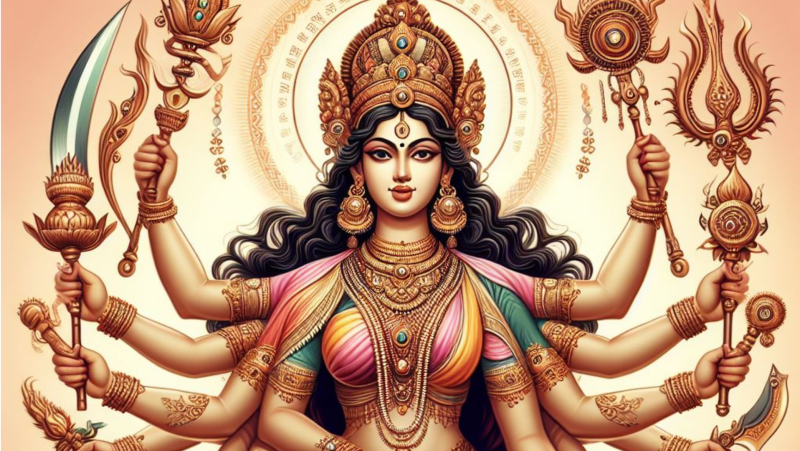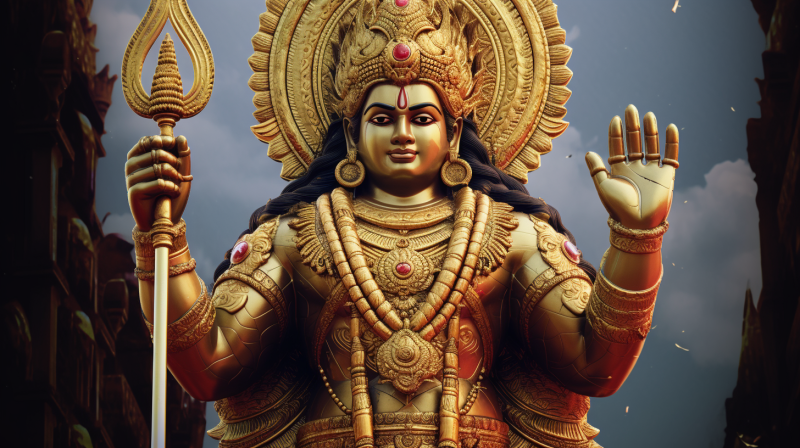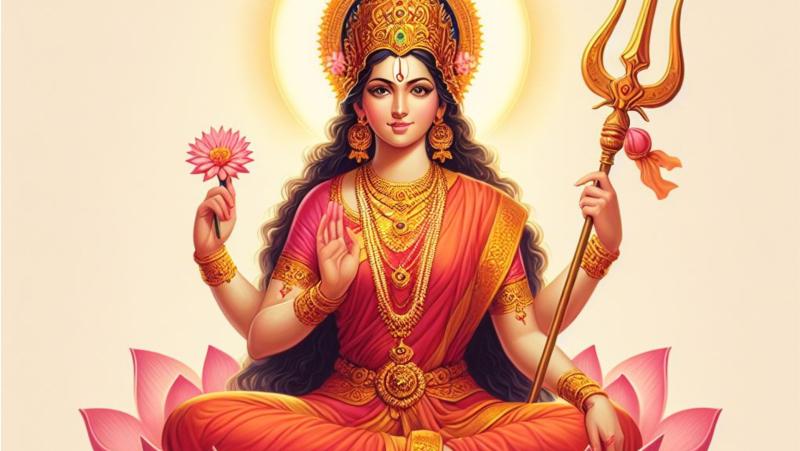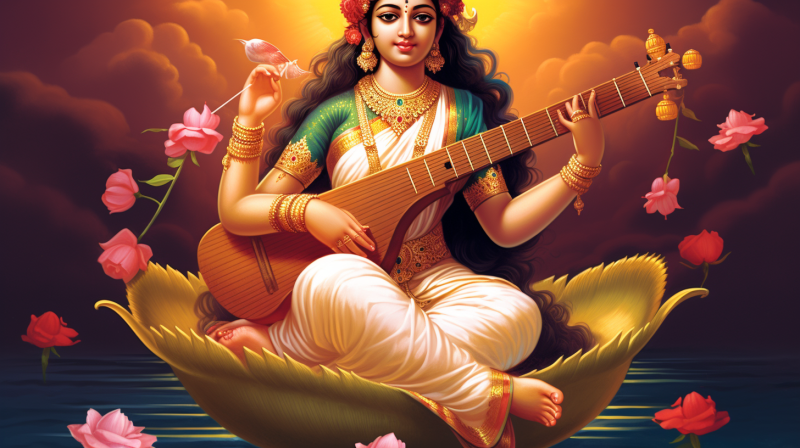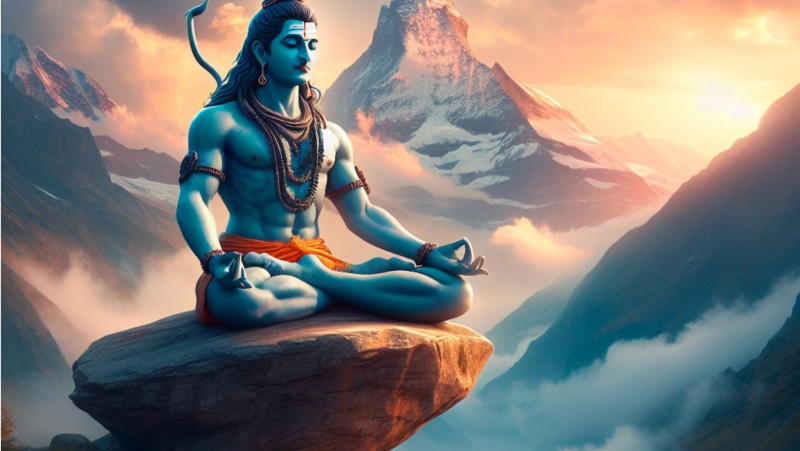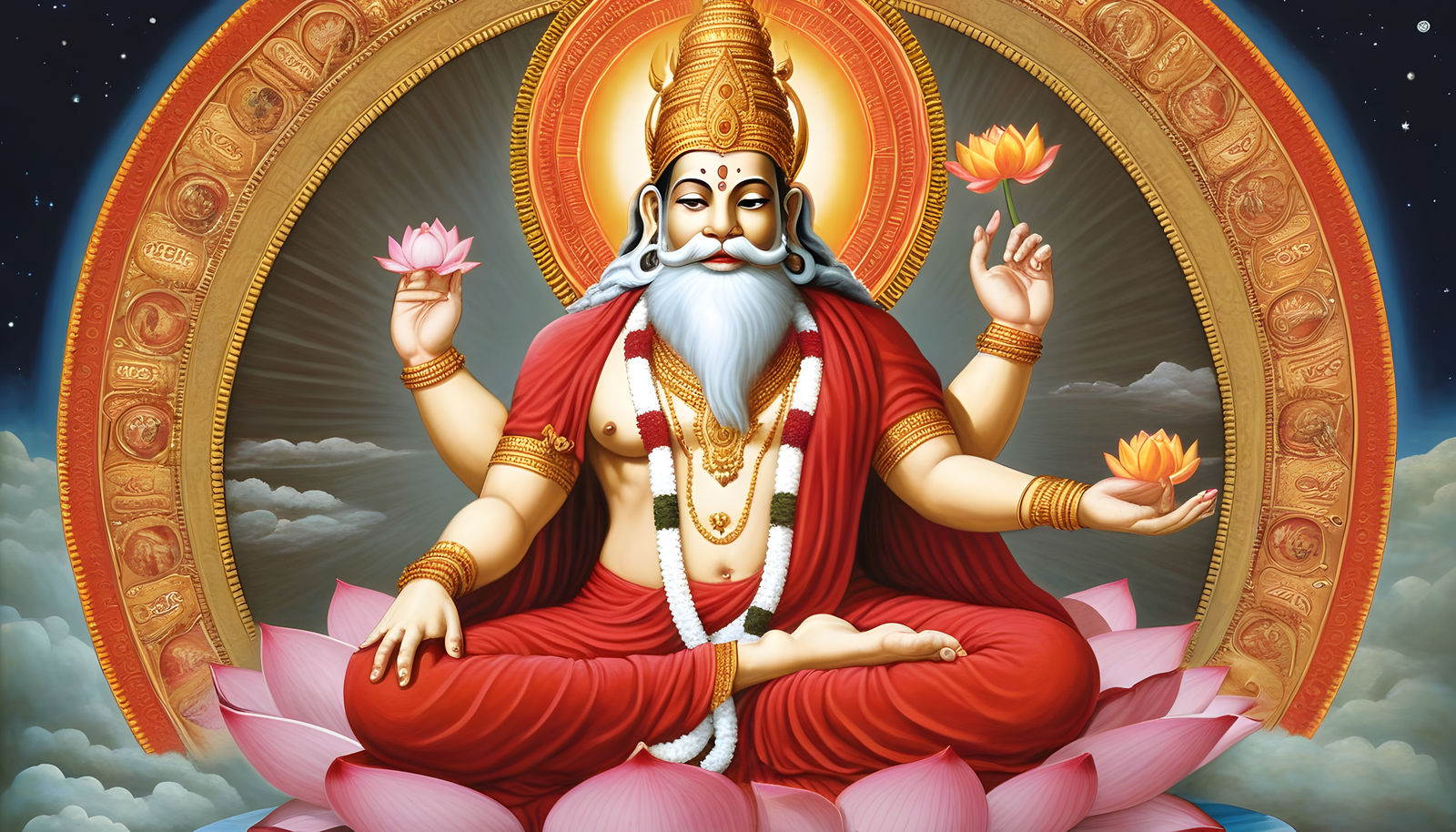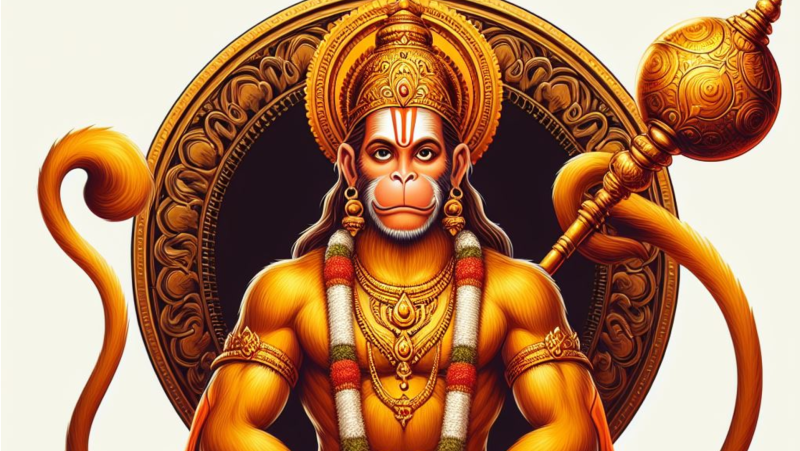
Hanuman, also known as the Monkey God, is one of the most revered and celebrated deities in Hinduism. He holds a special place in the hearts of millions of devotees worldwide due to his unwavering devotion, immense strength, and selfless service. Here's a comprehensive overview of Hanuman and his significance:
Hanuman Ji Birth and Origin
The birth and origin of Hanuman, the Monkey God, are detailed in Hindu mythology and scriptures. Hanuman's birth is a divine and extraordinary event.
Here's a detailed account of his birth and origin:
1. Divine Parents:
• Hanuman was born to Anjana and Kesari. Anjana was a celestial nymph (apsara) known for her beauty and purity. She was married to Kesari, who was the chief of the monkey tribe called the "Vanaras."
2. Anjana's Curse and Redemption:
• Anjana, despite her celestial origin, had incurred a curse that transformed her into a monkey. To be redeemed from this curse and regain her celestial form, she was destined to give birth to an incarnation of Lord Shiva.
3. Divine Conception:
• Anjana and Kesari were ardent devotees of Lord Shiva. Through their intense devotion and penance, they gained the favor of Lord Shiva and his consort, Parvati.
• Lord Shiva blessed Anjana with a divine boon, promising that he would be born as her son.
• As a result of Lord Shiva's boon, Hanuman was conceived in Anjana's womb, making him a partial incarnation of Lord Shiva.
4. Wind God's Role:
• Additionally, Vayu, the god of wind, played a significant role in Hanuman's birth. Vayu was drawn to Anjana's unparalleled devotion and purity.
• One day, as Anjana was performing her daily prayers, Vayu approached her and transferred a small portion of his own divine energy into her womb, ensuring that Hanuman would inherit the qualities of the wind, such as swiftness and strength.
5. Birth on Anjanadri Hill:
• Hanuman was born on the Anjanadri Hill, which is located near Hampi in present-day Karnataka, India.
• His birthplace is considered sacred, and a temple dedicated to Hanuman stands there to this day.
6. Name "Hanuman":
• The name "Hanuman" is derived from the Sanskrit word "Hanu," which means "jaw," and "man" or "mant," which means "disfigured" or "broken." Hanuman's name is believed to have been given because his jaw was injured as a result of his youthful antics.
7. Childhood Exploits:
• Hanuman's childhood was marked by numerous divine exploits and playful adventures. One famous incident involves him attempting to swallow the sun, mistaking it for a fruit, which led to a confrontation with Lord Indra, the king of the gods.
8. Lifelong Devotion to Lord Rama:
• As Hanuman grew older, his devotion to Lord Rama, an avatar of Lord Vishnu, became his defining characteristic. His unwavering loyalty and selfless service to Lord Rama form the central theme of the Ramayana, one of the most important Hindu epics.
Hanuman's birth and origin are rooted in divine blessings, the fulfillment of celestial prophecies, and his destiny as a devoted servant of Lord Rama. His life story serves as an inspiring example of unwavering faith, devotion, and the triumph of good over evil in Hindu mythology and culture.
Hanuman Physical Appearance
Hanuman, the Monkey God, is typically depicted with distinctive physical attributes in Hindu iconography. His appearance carries symbolic and mythological significance. Here's an explanation of Hanuman's physical appearance:
1. Monkey-Faced: Hanuman is invariably depicted with the face of a monkey, which is one of his most defining features. His monkey face signifies his lineage as a Vanara (a race of monkey-like beings) and symbolizes his agility, intelligence, and resourcefulness.
2. Muscular Body: Hanuman is often portrayed with a robust and muscular physique, emphasizing his immense strength and physical prowess. His muscular form represents his capability to perform extraordinary feats.
3. Orange or Reddish-Brown Complexion: Hanuman's body is typically depicted with an orange or reddish-brown complexion. This color symbolizes his association with Lord Shiva, as red or orange is often associated with asceticism and renunciation.
4. Loincloth (Kaupina): Hanuman is usually shown wearing a loincloth or a simple piece of cloth around his waist. This minimalist attire reflects his ascetic and humble nature.
5. Tail: Hanuman's tail is an integral part of his depiction. It is long, curled, and often rests gracefully behind him. In Hindu mythology, his tail is sometimes described as being on fire during his leap to Lanka to rescue Sita. This tail symbolizes his agility and mobility.
6. Mace (Gada): Hanuman is often depicted holding a mace (gada) in one hand, symbolizing his immense physical strength and his role as a protector of dharma (righteousness).
7. Mountain (Sanjeevani Parvat): In some depictions, Hanuman is shown carrying a mountain. This mountain is identified as the "Sanjeevani Parvat," and it symbolizes Hanuman's ability to lift and carry colossal objects. According to the Ramayana, Hanuman brought this mountain to Lanka to save Lord Lakshmana's life.
8. Ornaments: Although Hanuman's attire is simple, he is sometimes adorned with various ornaments, such as armlets, bracelets, and a necklace, which reflect his divine nature and valor.
9. Mudra (Hand Gestures): Hanuman's hand gestures, or mudras, can vary. He is often depicted in the Anjali Mudra (palms pressed together in a gesture of respect or devotion) as a sign of his unwavering devotion to Lord Rama.
10. Third Eye: In some representations, Hanuman is depicted with a third eye on his forehead, symbolizing his inner vision and spiritual insight.
Hanuman's physical appearance is not only a representation of his divine attributes but also a source of inspiration for devotees. His monkey face and powerful form convey qualities of humility, devotion, and strength, making him a beloved deity in Hinduism who continues to inspire millions around the world.
Devotion to Lord Rama
Hanuman's devotion to Lord Rama is one of the most celebrated and profound examples of bhakti (devotion) in Hindu mythology. Hanuman's unwavering dedication and love for Lord Rama are central to the epic Ramayana and continue to inspire countless devotees. Here's an explanation of Hanuman's devotion to Lord Rama:
1. Early Encounter: Hanuman's devotion to Lord Rama begins when he meets Rama, who, along with his brother Lakshmana and wife Sita, is in exile in the forest. Hanuman, the minister of the monkey king Sugriva, becomes aware of Lord Rama's mission to rescue Sita from the demon king Ravana.
2. Offering His Services: Hanuman realizes that Bhagwan Ram is an incarnation of Lord Vishnu and the embodiment of dharma (righteousness). Filled with devotion, he decides to offer his services to Lord Rama in his quest to rescue Sita. He sees this as a divine opportunity to serve the Lord.
3. Leaping to Lanka: Hanuman's devotion is vividly demonstrated when he leaps across the ocean from the southern tip of India to the island of Lanka (modern-day Sri Lanka) to search for Sita. His incredible leap is fueled by his deep faith in Lord Rama's cause and his determination to find Sita.
4. Locating Sita: Hanuman successfully locates Sita in Lanka and delivers Lord Rama's message to her. He assures her of Rama's unwavering love and commitment to rescuing her. This act of delivering Rama's message is another expression of his devotion.
5. Battle Against Ravana's Forces: Hanuman's devotion is further exemplified during the battle with Ravana's demon army. Despite being captured and subjected to various trials, Hanuman never wavers in his loyalty to Lord Rama. He repeatedly chants Lord Rama's name, which strengthens and protects him.
6. Carrying the Sanjeevani Mountain: In one of the most iconic episodes, Hanuman carries the entire Sanjeevani Parvat (mountain) to Lanka to save Lord Lakshmana's life. This remarkable feat is a testament to his devotion and his willingness to go to any lengths to serve Lord Rama and his devotees.
7. Carrying Rama and Sita in His Heart: Hanuman's devotion is so deep that he once tears open his chest to reveal Lord Rama and Sita residing in his heart. This act symbolizes his belief that they are the essence of his existence.
8. Lord Rama's Appreciation: Lord Rama greatly appreciates Hanuman's unwavering devotion and selfless service. He embraces Hanuman as a dear friend and devotee, and their bond becomes a model of divine love and friendship.
9. Chiranjivi (Immortality): Hanuman is believed to be a chiranjivi, an immortal being in Hinduism. His undying devotion to Lord Rama grants him eternal life, symbolizing the enduring power of bhakti.
Hanuman's devotion to Lord Rama serves as an inspirational example of selfless love and surrender to the divine. It underscores the central theme of bhakti, emphasizing that true devotion involves complete surrender to God and a willingness to serve the divine with unwavering faith, no matter the challenges or obstacles encountered along the way.
Hanuman Strength and Powers
Hanuman is renowned for his extraordinary strength and divine powers, which play a pivotal role in the Hindu epic, the Ramayana, and various other texts and traditions. His strength and abilities are manifestations of his divine nature and his role as a devoted servant of Lord Rama. Here's an explanation of Hanuman's strength and powers:
1. Physical Strength:
• Hanuman possesses immense physical strength. His muscular and robust form enables him to perform remarkable feats of physical prowess.
• In the Ramayana, Hanuman exhibits his strength by lifting and carrying a massive mountain, the Sanjeevani Parvat, to Lanka to save Lord Lakshmana's life.
2. Ability to Change Size:
• Hanuman has the power to alter his size at will. He can shrink to the size of a small insect or expand to become gigantic, depending on the situation.
• This power allows him to sneak into Lanka in a diminutive form and carry out reconnaissance while also assuming a colossal form when needed.
3. Flight:
• Hanuman has the ability to fly, and he uses this power extensively in his search for Sita and in delivering messages to Lord Rama.
• His aerial journey across the ocean to Lanka is one of the most iconic episodes in the Ramayana.
4. Immunity to Weapons:
• Hanuman is immune to ordinary weapons. He is blessed with a protective shield that renders him impervious to arrows, swords, and other conventional weapons.
• This immunity serves him well in his various battles and encounters with demons.
5. Intellect and Wisdom:
• While Hanuman is renowned for his physical strength, he is also incredibly intelligent and wise. His knowledge encompasses a wide range of subjects, including scriptures, medicine, and astrology.
• His wisdom and intelligence are evident in his strategic planning and problem-solving abilities throughout the Ramayana.
6. Shapeshifting Abilities:
• Hanuman can assume different forms as needed. He uses this power to disguise himself and infiltrate enemy camps without detection.
• This shapeshifting ability allows him to gather valuable information and perform covert missions.
7. Devotion-Enhanced Powers:
• Hanuman's powers are further amplified by his unwavering devotion to Lord Rama. His deep love and loyalty to Rama infuse his actions with divine energy and strength.
• Chanting Lord Rama's name invokes spiritual power in Hanuman, enhancing his abilities.
8. Symbolic Powers:
• Hanuman's powers also carry symbolic significance. His strength represents the triumph of good over evil, and his ability to soar above obstacles symbolizes the human spirit's potential to overcome challenges.
Hanuman's strength and powers serve as a testament to his divine nature and his role as a devoted servant of Lord Rama. His extraordinary abilities make him one of the most revered and beloved deities in Hinduism, embodying the ideals of devotion, courage, and selfless service.
Hanuman Symbolism and Attributes
Hanuman, the Monkey God, is a highly symbolic figure in Hinduism, and his attributes carry deep meaning and spiritual significance. Here's an explanation of Hanuman's symbolism and attributes:
1. Monkey Symbolism:
• Hanuman's monkey face symbolizes agility, intelligence, and adaptability. It represents the idea that one should be nimble and resourceful in facing life's challenges.
• Monkeys are also known for their unwavering loyalty to their troops. Hanuman's loyalty to Lord Rama and his unwavering devotion exemplify this quality.
2. Red Complexion:
• Hanuman is often depicted with an orange or reddish-brown complexion. This color symbolizes his association with Lord Shiva, as red is a color associated with asceticism and renunciation.
• It also signifies his passionate devotion to Lord Rama and his selfless service.
3. Loincloth (Kaupina):
• Hanuman's attire is simple and minimalist, typically consisting of a loincloth tied around his waist. This attire reflects his ascetic and humble nature. It symbolizes detachment from material possessions and a focus on spiritual goals.
4. Tail:
• Hanuman's tail, often curled behind him, symbolizes his agility and adaptability. It represents his ability to navigate through life's challenges with grace and flexibility.
• In Hindu mythology, the tail also signifies a symbol of vitality and strength.
5. Mace (Gada):
• Hanuman is frequently depicted holding a mace (gada) in one hand. The mace symbolizes his immense physical strength and his role as a protector of dharma (righteousness).
• It signifies his commitment to upholding righteousness and defeating evil forces.
6. Mountain (Sanjeevani Parvat):
• Hanuman is sometimes shown carrying a mountain, the Sanjeevani Parvat, on his palm. This mountain symbolizes his dedication and willingness to go to great lengths to serve and protect those he loves.
• It also highlights his ability to bring life-saving remedies even in the most challenging circumstances.
7. Third Eye:
• In some depictions, Hanuman is portrayed with a third eye on his forehead. This third eye represents his inner vision and spiritual insight.
• It symbolizes his deep understanding of the divine and his unwavering focus on Lord Rama.
8. Anjali Mudra (Hand Gesture):
• Hanuman is often shown with his hands folded in the Anjali Mudra (palms pressed together in a gesture of respect or devotion). This gesture signifies his deep reverence and devotion to Lord Rama.
• It reflects the humility and surrender of a true devotee.
9. Ring:
• Hanuman is sometimes depicted wearing a ring on his finger, which contains the name of Lord Rama. This ring is a symbol of his unbroken connection to Lord Rama and his unwavering devotion.
10. Bhakti (Devotion) and Surrender:
• Above all, Hanuman's most profound symbolism lies in his unwavering devotion and selfless surrender to Lord Rama. He exemplifies the ideal devotee who completely dedicates himself to the service and love of the divine.
Hanuman's symbolism and attributes convey important spiritual lessons, emphasizing qualities such as humility, devotion, strength, and unwavering loyalty. He serves as a role model for those on the spiritual path, reminding them of the values and qualities that lead to a deeper connection with the divine.
Chiranjivi (Immortal Being)
Hanuman is often regarded as a "Chiranjivi," which means an immortal being or one who lives eternally in Hindu mythology. This status as a Chiranjivi is attributed to his unique and divine qualities. Here's an explanation of Hanuman's Chiranjivi status:
1. Blessed with Immortality by Boons:
• Hanuman's immortality is primarily attributed to the divine boons (blessings) he received from various gods during his early life and his service to Lord Rama.
• As a child, Hanuman was blessed with multiple boons by different deities. For example, Lord Shiva granted him a boon of immortality, which ensured that he would live for as long as the story of Lord Rama's deeds is narrated and remembered on Earth.
2. Elixir of Immortality (Sanjeevani Herb):
• Another source of Hanuman's immortality is his association with the Sanjeevani Parvat (mountain). During the battle in the Ramayana, Hanuman carried this mountain to Lanka to save Lord Lakshmana's life by obtaining the Sanjeevani herb.
• While he is often depicted carrying the entire mountain, some versions of the story suggest that he only carried a part of it. Either way, his association with the Sanjeevani herb is seen as a source of his longevity.
3. Devotion and Divine Blessings:
• Hanuman's immortality is also linked to his unwavering devotion to Lord Rama. His selfless service, dedication, and unbreakable bond with Lord Rama are considered to be of such significance that they grant him an enduring presence in the spiritual and mythological narratives of Hinduism.
4. Chiranjivi Status in Hindu Belief:
• In Hindu belief, there are several Chiranjivi or immortal beings who are destined to live throughout the ages and play specific roles in the grand cosmic narrative.
• These Chiranjivi include Hanuman, as well as others like Lord Parashurama, Vibhishana (brother of Ravana), and Ashwatthama (from the Mahabharata).
5. Continued Worship and Cultural Significance:
• Hanuman's Chiranjivi status is reflected in the ongoing worship and devotion he receives from millions of people across the world. His temples, chants, and festivals are a testament to his enduring presence in Hindu culture and spirituality.
6. Symbol of Devotion and Service:
• Hanuman's immortality symbolizes the eternal nature of devotion and selfless service to a higher spiritual ideal, which transcends the limitations of time and space.
• His life story and devotion continue to inspire people in their spiritual journeys and reinforce the belief in the power of unwavering faith and dedication.
In essence, Hanuman's Chiranjivi status signifies not only his immortality in the mythological and spiritual realm but also the enduring legacy of devotion, selfless service, and the eternal presence of his story as a source of inspiration for countless devotees.
Hanuman Ji Temples and Worship
Hanuman temples are abundant throughout India and in many other parts of the world with a significant Hindu population. Hanuman is one of the most beloved deities in Hinduism, and his temples are places of worship and devotion for millions of people. Here's an explanation of Hanuman temples and the worship associated with them:
1. Design and Architecture:
• Hanuman temples vary in architectural styles, but they typically feature an image or idol of Hanuman.
• The central sanctum (garbhagriha) of the temple contains the main deity, often in a standing or sitting posture.
• Hanuman idols are commonly depicted holding a mace (gada) and in a posture of devotion, often with hands folded in the Anjali Mudra (palms pressed together).
2. Prayers and Offerings:
• Devotees visit Hanuman temples to offer their prayers and seek blessings for various purposes, including courage, strength, protection, and success in their endeavors.
• Common offerings include flowers, fruits, coconuts, and sweets, which are presented to the deity as a token of devotion.
• Devotees may also light incense and lamps (diyas) as acts of worship.
3. Chanting of Hanuman Chalisa:
• The "Hanuman Chalisa" is a devotional hymn dedicated to Hanuman, composed by the poet Tulsidas. It is one of the most widely recited texts in Hinduism.
• Devotees often gather in Hanuman temples to chant the Hanuman Chalisa, either individually or collectively, as a form of devotion and meditation.
4. Tuesdays and Saturdays:
• Tuesdays and Saturdays are considered especially auspicious for Hanuman worship, and these days often see larger congregations of devotees.
• It's common for devotees to fast or perform special rituals on these days and visit Hanuman temples to seek his blessings.
5. Hanuman Jayanti:
• Hanuman Jayanti is the birthday celebration of Hanuman, which usually falls in March or April. It is a significant festival for Hanuman devotees.
• Temples are beautifully decorated, and special prayers and processions are organized to celebrate this occasion.
6. Hanuman Arati:
• Arati is a ritual of waving lamps in front of the deity. The Hanuman Arati is performed in temples to the accompaniment of devotional songs and hymns.
• It is a moment of devotion when devotees express their love and gratitude to Hanuman.
7. Temple Rituals and Pujas:
• Temples have resident priests who conduct regular rituals and pujas (ceremonial worship) on behalf of devotees.
• Special pujas and yagnas (fire rituals) dedicated to Hanuman are performed on auspicious occasions.
8. Pilgrimage Sites:
• There are several famous Hanuman pilgrimage sites in India, such as the Hanuman Temple in Varanasi, where it is believed that Lord Hanuman appeared in person.
• Other notable pilgrimage sites include the Hanuman Dhara Temple in Chitrakoot and the Sankat Mochan Hanuman Temple in Benaras.
Hanuman temples and worship serve as places of solace, inspiration, and spiritual connection for devotees. Hanuman's qualities of devotion, strength, and unwavering loyalty continue to resonate with people, making his temples important centers of religious and cultural significance.
Hanuman Chalisa
The Hanuman Chalisa is a devotional hymn dedicated to Lord Hanuman, the Monkey God, and one of the most widely recited and revered texts in Hinduism. Composed by the 16th-century Indian poet and saint Tulsidas, the Hanuman Chalisa is a 40-verse prayer that extols the virtues, exploits, and qualities of Hanuman. It is chanted by millions of devotees to seek Hanuman's blessings, strength, courage, and protection. Here's an overview of the
Hanuman Chalisa:
Structure and Verses:
• The Hanuman Chalisa is composed in the Awadhi language, a dialect of Hindi, and consists of 40 verses (chalisa), hence its name. Each verse follows a specific meter and rhyme scheme, making it melodious to chant.
Opening Verses:
• The Hanuman Chalisa begins with two introductory verses in which Tulsidas describes his own limitations and praises Hanuman's qualities as a devotee and an avatar of Lord Shiva.
Praise and Description of Hanuman:
• The following verses elaborate on Hanuman's physical attributes, his divine origin, his role in the Ramayana, and his devotion to Lord Rama.
• Hanuman's virtues such as wisdom, strength, humility, and unwavering devotion are extolled in these verses.
Narration of Hanuman's Exploits:
• Several verses narrate the story of Hanuman's leap across the ocean to Lanka, his search for Sita, his encounter with various demons, and his role in the battle against the demon king Ravana.
• These verses describe Hanuman's extraordinary feats and his selfless service to Lord Rama and Sita.
Benefits and Blessings:
• The Hanuman Chalisa emphasizes the benefits of chanting it regularly. Devotees believe that it can bring protection from harm, courage, strength, and relief from suffering.
• It is also said to grant spiritual insight, dispel negativity, and foster devotion to Lord Rama.
Conclusion:
• The Hanuman Chalisa concludes with a plea to Hanuman to bestow his blessings and protect the devotee from fear, suffering, and evil influences.
• It ends with Tulsidas requesting Hanuman to dwell in his heart and grant the ultimate boon of spiritual wisdom.
Recitation and Devotion:
• Devotees recite the Hanuman Chalisa with deep devotion and concentration. It is often chanted daily or on Tuesdays and Saturdays, which are considered auspicious days for Hanuman worship.
• Chanting the Hanuman Chalisa is a form of bhakti (devotion) and meditation, and it is believed to bring the devotee closer to Hanuman and the divine.
The Hanuman Chalisa serves as both a spiritual text and a source of inspiration. It is not only a powerful prayer but also a literary masterpiece in its own right, revered for its devotion to Hanuman and its encapsulation of the teachings of Lord Rama. Many people find solace, strength, and a sense of connection with the divine through the regular recitation of the Hanuman Chalisa.
Cultural Significance of Hanuman
The cultural significance of Hanuman extends beyond the boundaries of religion and spirituality in India. Hanuman is a beloved and revered figure whose influence has permeated various aspects of Indian culture and society. Here's an explanation of Hanuman's cultural significance:
1. Symbol of Strength and Courage:
• Hanuman is widely regarded as a symbol of physical and mental strength, courage, and resilience.
• His unwavering devotion and fearless actions in the Ramayana have made him an iconic figure of bravery, inspiring people to face life's challenges with determination.
2. Devotion and Bhakti:
• Hanuman exemplifies the qualities of devotion and bhakti (religious devotion) in Hinduism. His complete surrender to Lord Rama sets an example for devotees, emphasizing the importance of unwavering faith and loyalty.
• Hanuman's devotion to Lord Rama has led to the widespread belief that chanting his name or reciting the Hanuman Chalisa can bring blessings, protection, and spiritual insight.
3. Protector and Guardian:
• Hanuman is often revered as a guardian and protector. His image is placed at the entrance of homes, temples, and other buildings to ward off negative influences and bring positivity and strength.
• The practice of hanging a Hanuman pendant or talisman for protection is common.
4. Cultural Festivals:
• Hanuman Jayanti, the celebration of Hanuman's birthday, is a major cultural event in many parts of India. It involves elaborate processions, temple visits, and recitation of the Hanuman Chalisa.
• The festival showcases the cultural diversity and unity of the Indian people in their devotion to Hanuman.
5. Art and Literature:
• Hanuman's character and exploits are a popular subject in Indian art, literature, and folklore.
• He is a central character in the Ramayana, a foundational epic of Indian culture, and his stories have been retold in numerous regional languages and art forms.
6. Inspiration in Popular Culture:
• Hanuman's stories have permeated popular culture in India. His tales are adapted into comic books, television shows, and movies.
• His image often adorns posters, merchandise, and even tattoos, reflecting his enduring influence in modern Indian culture.
7. Physical Fitness and Yoga:
• Hanuman's physical strength and agility have made him an icon in the realms of physical fitness and yoga. Postures like "Hanumanasana" (the monkey pose) in yoga are inspired by his legendary leap to Lanka.
• His image is sometimes associated with sports teams and athletic clubs, signifying determination and strength.
8. Cross-Cultural Appeal:
• Hanuman's universal appeal extends beyond Hinduism. People from various cultural backgrounds appreciate the values he represents, such as loyalty, service, and devotion.
• His stories and messages have also resonated with followers of yoga, meditation, and Eastern spirituality worldwide.
Hanuman's cultural significance in India is a testament to the enduring power of his character and teachings. His qualities of devotion, strength, and service continue to inspire and unite people across diverse communities, making him an integral part of India's rich cultural tapestry.
Variations and Regional Worship
The worship of Hanuman is deeply ingrained in Hinduism, and regional variations in his worship have led to a diverse range of traditions and practices across India. Here's an explanation of some variations and regional aspects of Hanuman worship:
1. North India:
• Ayodhya: Ayodhya, the birthplace of Lord Rama, has several Hanuman temples, including the Hanuman Garhi temple. Hanuman is regarded as a guardian deity of Ayodhya and is worshipped with great devotion here.
• Varanasi (Benaras): The Sankat Mochan Hanuman Temple in Varanasi is one of the most famous Hanuman temples in North India. It has a unique tradition of applying orange sindoor (vermilion) to Lord Hanuman's idol, and devotees believe that it grants protection and fulfillment of wishes.
2. Central India:
• Madhya Pradesh: The state of Madhya Pradesh has several ancient Hanuman temples, particularly in places like Chitrakoot, Jabalpur, and Gwalior. These temples are known for their historical and spiritual significance.
• Orchha: The Ram Raja Temple in Orchha, Madhya Pradesh, features Lord Rama as the reigning king, and Hanuman is considered his faithful minister. The temple has a unique blend of Ram and Hanuman worship.
3. Western India:
• Gujarat: The Hanuman Akhara in Vadodara, Gujarat, is known for its traditional wrestling and physical fitness training. Wrestlers offer prayers to Hanuman for strength and success.
• Maharashtra: The shrine of Lord Hanuman at Shri Rama Kshetra, better known as Hampi, in Karnataka has historical and architectural significance. It is believed that Hanuman lived here during Lord Rama's exile.
4. Southern India:
• Karnataka: The Anjaneya Temple in Hampi, Karnataka, is believed to be the birthplace of Hanuman according to local tradition. It is a prominent pilgrimage site for Hanuman devotees.
• Kerala: In Kerala, Hanuman is worshipped in the form of "Kochuveli Bhagavathi Amman," a unique manifestation of Hanuman with a female appearance.
5. Eastern India:
• Bengal: Hanuman is worshipped in various forms, including Panchamukhi Hanuman (five-faced Hanuman) and Sankat Mochan Hanuman, in Bengal. The Sankat Mochan Sreepur temple in Kolkata is famous for its annual Hanuman Jayanti celebrations.
• Assam: The Kamakhya Temple in Assam is known for its unique form of Hanuman worship as "Patal Hanuman" (Hanuman residing underground).
6. Tamil Nadu and South India:
• Tamil Nadu: The Meenakshi Temple in Madurai has a shrine dedicated to Lord Anjaneya (Hanuman). Tamil Nadu has a rich tradition of Hanuman bhakti with numerous temples devoted to him.
• Andhra Pradesh: The Mangalagiri Temple in Andhra Pradesh is a famous Hanuman temple known for its unique deity depicted with a mountain in hand.
These regional variations in Hanuman worship reflect the diversity of traditions and practices within Hinduism. While the core devotion to Hanuman remains constant, the rituals, customs, and legends associated with him can vary significantly from one region to another, enriching the tapestry of Hindu culture and spirituality.
In summary, Hanuman, the Monkey God, is a beloved deity in Hinduism known for his devotion to Lord Rama, his immense strength, and his embodiment of selfless service. His story and teachings continue to inspire millions of people, making him a symbol of unwavering faith and dedication in Hinduism and beyond.
You may also like …
Are You The Proud Hindu?
The Trimurti
Create an account to join us and start taking part in conversations.
SIGNIN